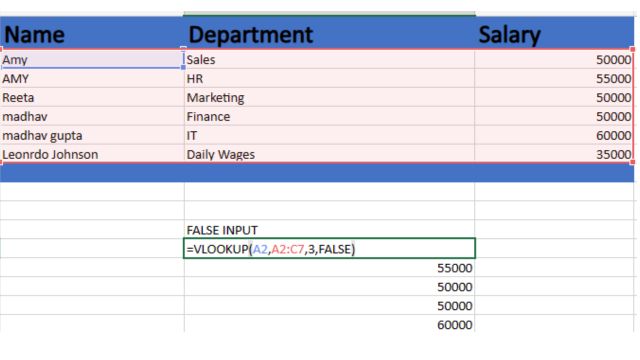What are the Benefits of Vlookup in Excel: VLOOKUP stands for “Vertical Lookup”. It is a powerful function in Microsoft Excel that lets you look for a specific value in a column of data and get information from columns next to it. It is one of the Excel tools that people use most often to analyze data and look things up.
Its syntax is easy to understand. So, most experienced Excel users will know how to use this function. VLOOKUP works like a phone book: you start with the data and look for matches.
What is Vlookup in Excel?
Vlookup is used for searching and retrieving data from tables. It is a powerful function of Microsoft excel. For close matches, VLOOKUP needs the data in the leftmost column of the table to be in ascending order. If the data are not in order, the function might give wrong results or not find the number you want. Make sure the data are in the right order before you use VLOOKUP.
The VLOOKUP function looks for the lookup value in the leftmost column of the table. It then gets the matching value from the column number in the same row. When using approximate matching or when using exact matching, if no exact match is found, the function can return an error number like #N/A.
What Are the Benefits of the Vlookup Formula in Accounting?
What are the Benefits of Vlookup in Excel In accounting and financial research. Here are some specific reasons why accountants like to use the VLOOKUP formula:
Quick Access to Financial Information: There are many situations in accounting where vlookup is used to know the salary of a person. It is also used to know the data of a particular person in a sheet. It is also used in transaction details and many more.
VLOOKUP lets you quickly find these values in big data sets and get the information that goes with them, saving you time and effort.
Error Reduction: Accounting involves working with a lot of numbers, and typing or looking for numbers by hand can lead to mistakes. VLOOKUP makes it easier to find and get information without making mistakes because it automates the process. This makes it less likely that financial estimates and reports will be wrong.
Streamlining Financial Analysis: Comparing data from different sources or looking at trends over time is often a part of financial research. VLOOKUP lets you combine information from different tables or worksheets, which makes it easier to do math and make reports. It lets you put together related pieces of information.
Accuracy in Reconciliations: Getting the balances of different accounts or systems to match up is a regular job. VLOOKUP can be used to match numbers between different sets of data and find differences. This helps to make sure that reconciliations are done correctly and to find any possible mistakes or omissions.
Efficient Management of Chart of Accounts: The chart of accounts is a key part of accounting that groups different kinds of financial events into different categories. VLOOKUP can help manage the chart of accounts by quickly getting account codes, descriptions, and other important information based on certain criteria. This makes it easier to give account codes to activities and check them.
Handling Pricing and Inventory Data: VLOOKUP can help businesses that need to manage and analyse information about their products or prices. It can be used to get price information for an object based on its code or to check the number of items in stock. This makes it easier to keep accurate price information and handle inventory well.
Automation of Recurring Tasks: In accounting, you often have to do the same things over and over again, like assigning prices or figuring out commissions. VLOOKUP can be used in formulas and templates to automate these jobs. This saves time and makes sure that calculations are always the same.
What Are the Benefits of the Vlookup Formula in Office?
In office use, the VLOOKUP formula is useful in many ways, no matter what area or role you have. Take a look on query what are the benefits of VLOOKUP in Excel and other office programs:
Data Retrieval: VLOOKUP lets you look for a specific number in a table and get the information from another column that goes with it. This is especially helpful when working with big databases or sets of data.
Accuracy: VLOOKUP lowers the chance that a person will make a mistake when looking up data by hand because it automates the lookup process. It makes sure that the information that is received is correct and consistent.
Enhance Productivity: VLOOKUP helps improve general productivity by making it easier to find data. It frees up your time so you can focus on analyzing the data and making good choices instead of looking for information.
User Friendly: VLOOKUP is pretty easy to use. It has a simple structure, so anyone who knows how to use Excel can understand and use it.
Dynamic Update According to Changes: VLOOKUP can instantly change the information it finds. This makes data easy to keep and work with datasets that change over time.
What Are the Uses of Vlookup Formula in Excel?

The Vlookup formula is commonly used in these things
Data Retrieval: With VLOOKUP, you can use a lookup number to find specific information in a table. For example, if you have a table with information about employees and you want to find out the pay of a certain employee, you can use VLOOKUP to look for the employee’s name and find the salary that goes with it.
Creating Dynamic Reports: You can make dynamic results with VLOOKUP by linking data from different tables. Using a shared identifier, you can use it to pull information from multiple tables into a single report.
Approximate Matching: VLOOKUP can find the best match to a lookup value in a list that has already been sorted. This is helpful when working with ranges or intervals, like figuring out the right tax rate based on income groups.
Financial Analysis: In financial research, VLOOKUP is often used to get data from outside sources, such as stock prices, interest rates, or exchange rates.
Cross Referencing: VLOOKUP can be used to link information from two or more tables. For example, if you have a table with product codes and their related descriptions, you can use VLOOKUP to find the description for a given product code.
Data Cleansing: VLOOKUP can help clean and standardize data by using a reference table to look up and replace inconsistent or wrong numbers with correct ones.
Take a Look At the Example of Vlookup Formula of Excel!
With Excel’s VLOOKUP function, you can look for a value in a table’s leftmost column and get a matching value from a different column. When you use VLOOKUP, you can tell it to use either TRUE or FALSE for the range_lookup argument.
If you set the range_lookup argument to TRUE (or leave it out, since it is optional), the VLOOKUP formula will try to find a match as close as possible. This means that it will look for a number in the leftmost column of the table that is close to the lookup value.
If it can’t find an exact match, it will return the closest match that is less than or equal to the lookup number. This is also called an “approximate match” or “range lookup.”
When the VLOOKUP function’s range_lookup input is set to FALSE, it does an exact match. This means that it will look for an exact match to the lookup value in the leftmost column of the table and return the matching value from a given column. Take a look at the video for example:
What Are the Limitations of Vlookup in Microsoft Excel?
Take a look at the limitations of vlookup formula in excel:
Single Column Lookup: VLOOKUP can only find numbers in the table’s leftmost column. This means that if the value you want to look up is not in the first column, you will need to rearrange your data or use other ways like INDEX-MATCH.
Exact Match Requirement: VLOOKUP is an exact match, so the number being looked up must be in the table. If VLOOKUP can’t find an exact match then it will give a warning. To do approximate matches. you need to set the “range_lookup” argument to “TRUE” or “1”.
Case Sensitivity: VLOOKUP doesn’t care about capitalization or lowercase letters. It treats both as the same. If your data is case sensitive, VLOOKUP might not give you the answers you want.
Limited To Vertical Lookup: VLOOKUP can only do vertical lookup, which means it looks for numbers in a column and gets information from the same row. If you need to do a horizontal finding, you’ll need to use HLOOKUP or another method like INDEX-MATCH.
Inflexible Column References: VLOOKUP gets data by using a set column reference. If you add or take away columns from the table, you have to change the column number in the formula by hand.
Performance Issues With Large Database: When you use VLOOKUP on big datasets it can become slow and inefficient. In these situations the performance can be improved by using other ways such as INDEX-MATCH or database functions like VBA (visual Basic Analysis).
Conclusion
Vlookup can be used to find the best match to a lookup value in a list, get data from outside sources, and link information from two or more tables.
It can also be used for data retrieval, data validation, creating dynamic reports, approximate matching, financial analysis, and cross referencing.
VLOOKUP is a useful formula for data cleaning and standardization, but it has limitations such as single column lookup, exact match requirement, case sensitiveness, limited to vertical lookup, inflexible column references, and slow performance on large databases. For more details and future updates bookmark our website and stay tuned with us.
